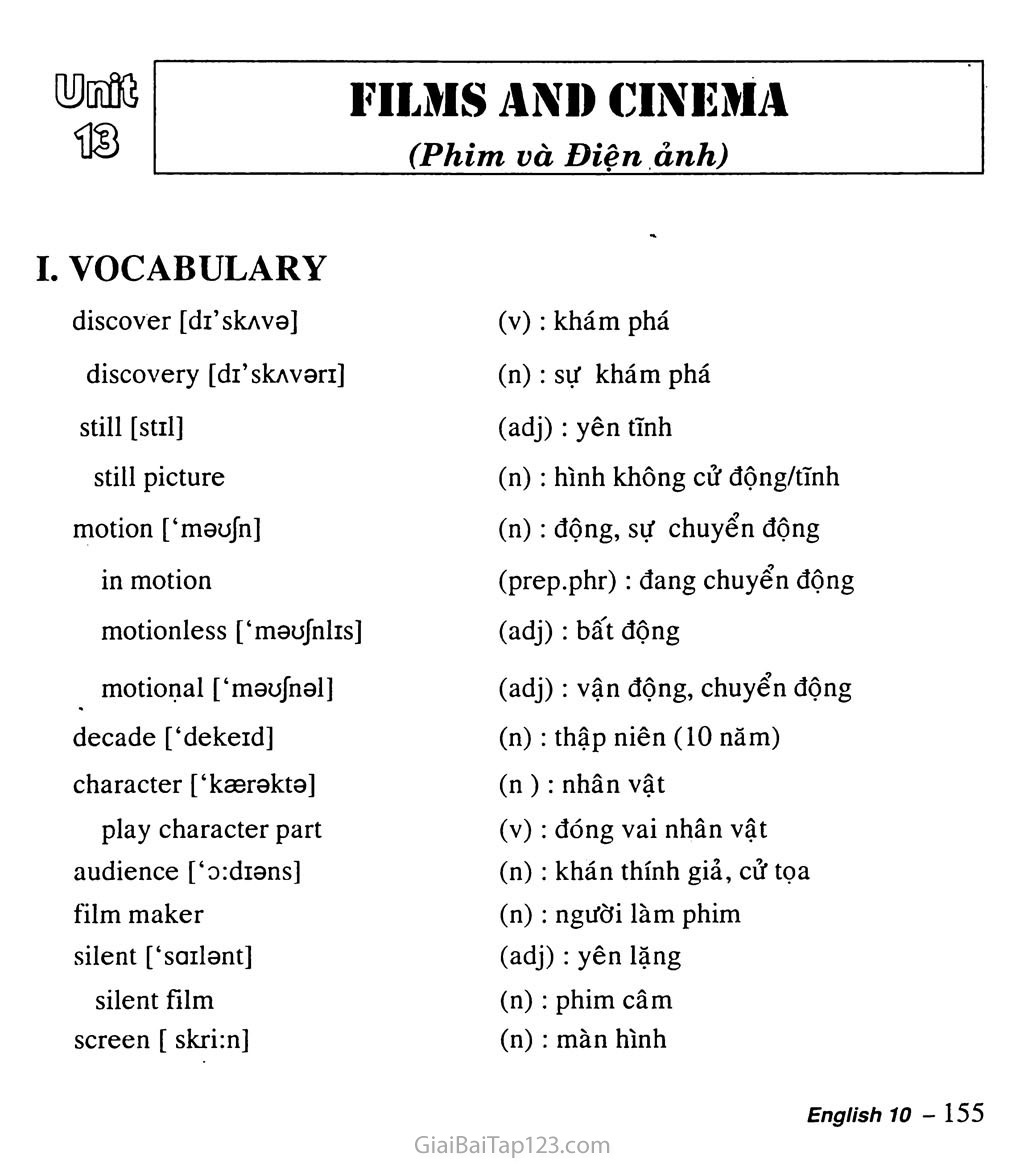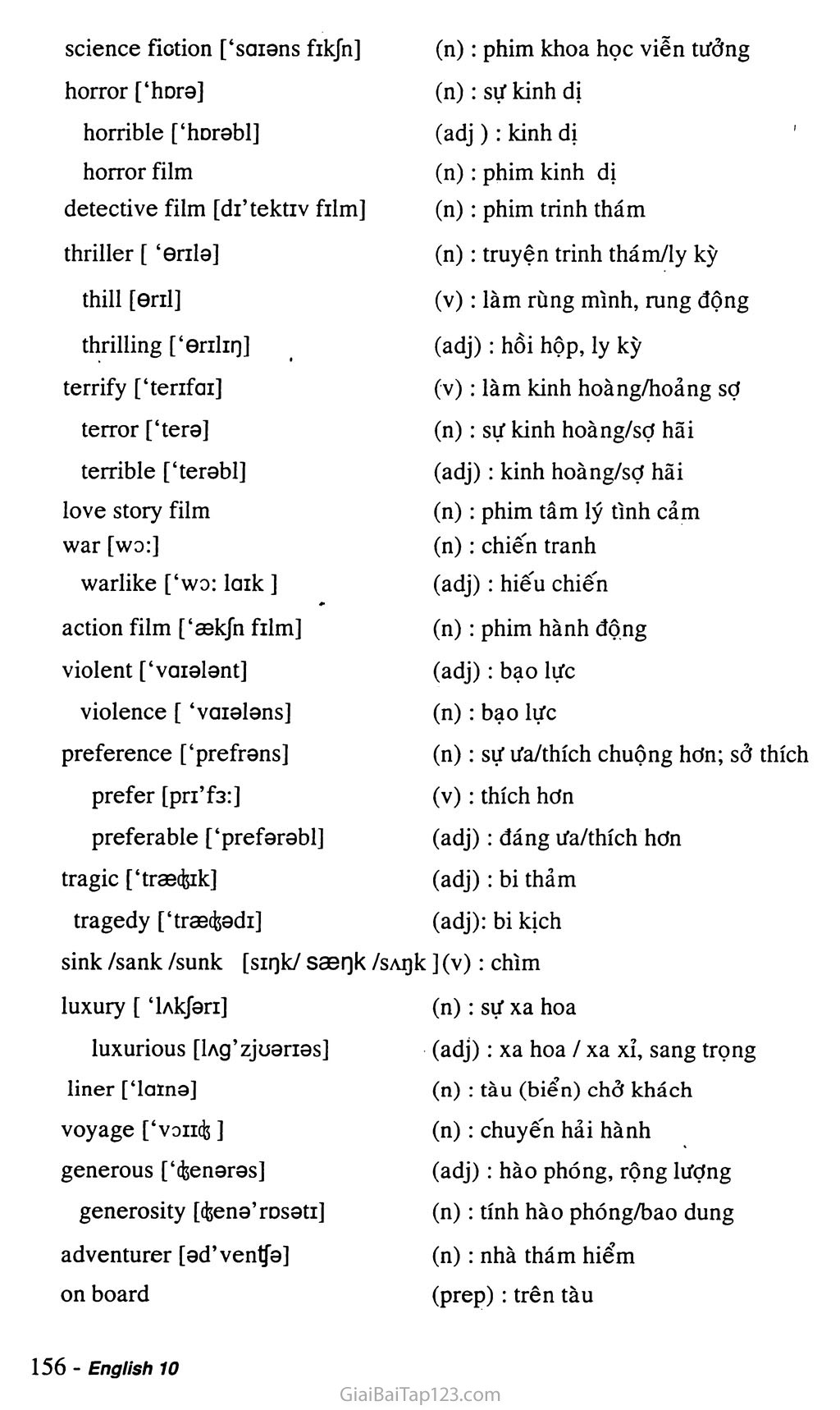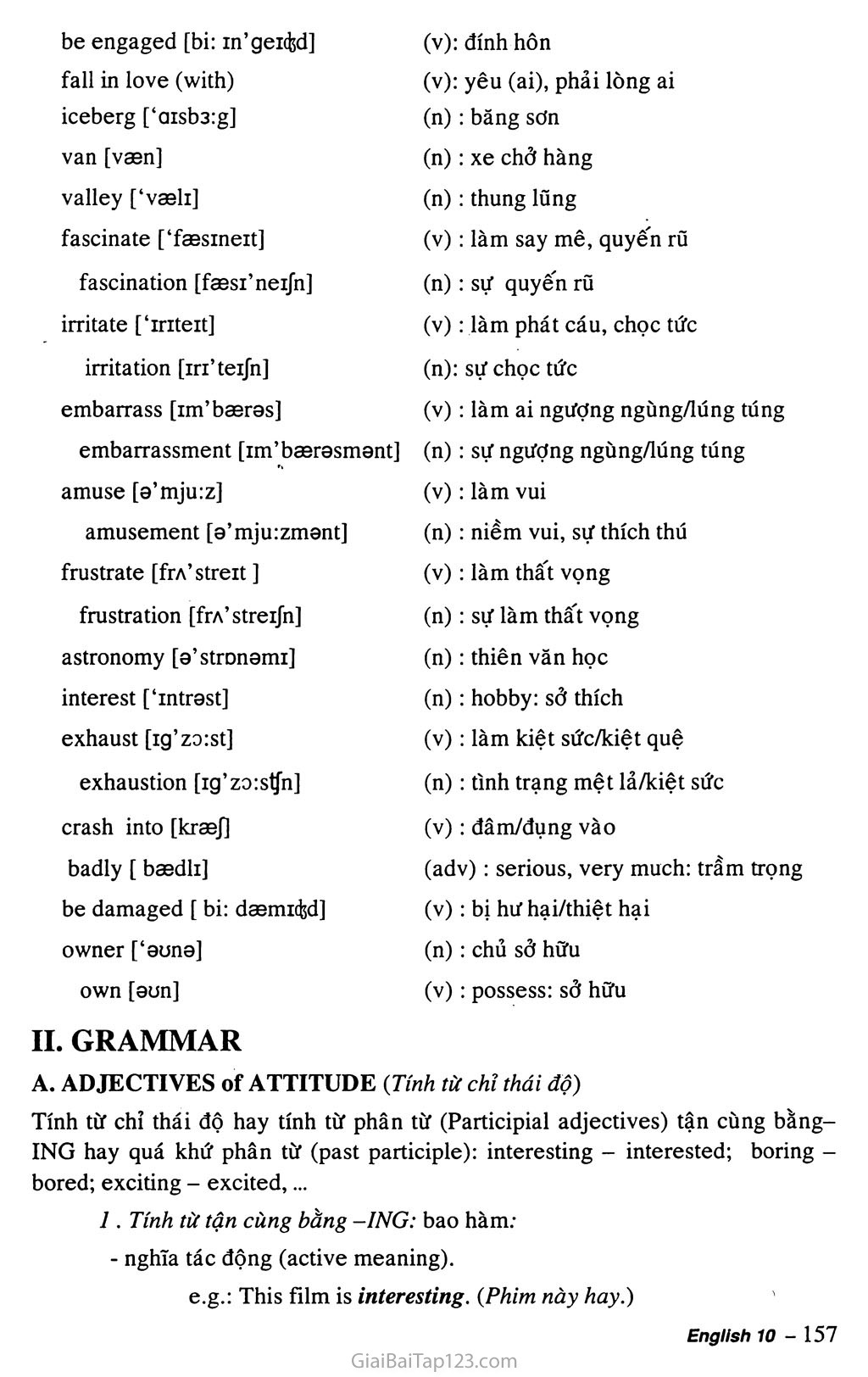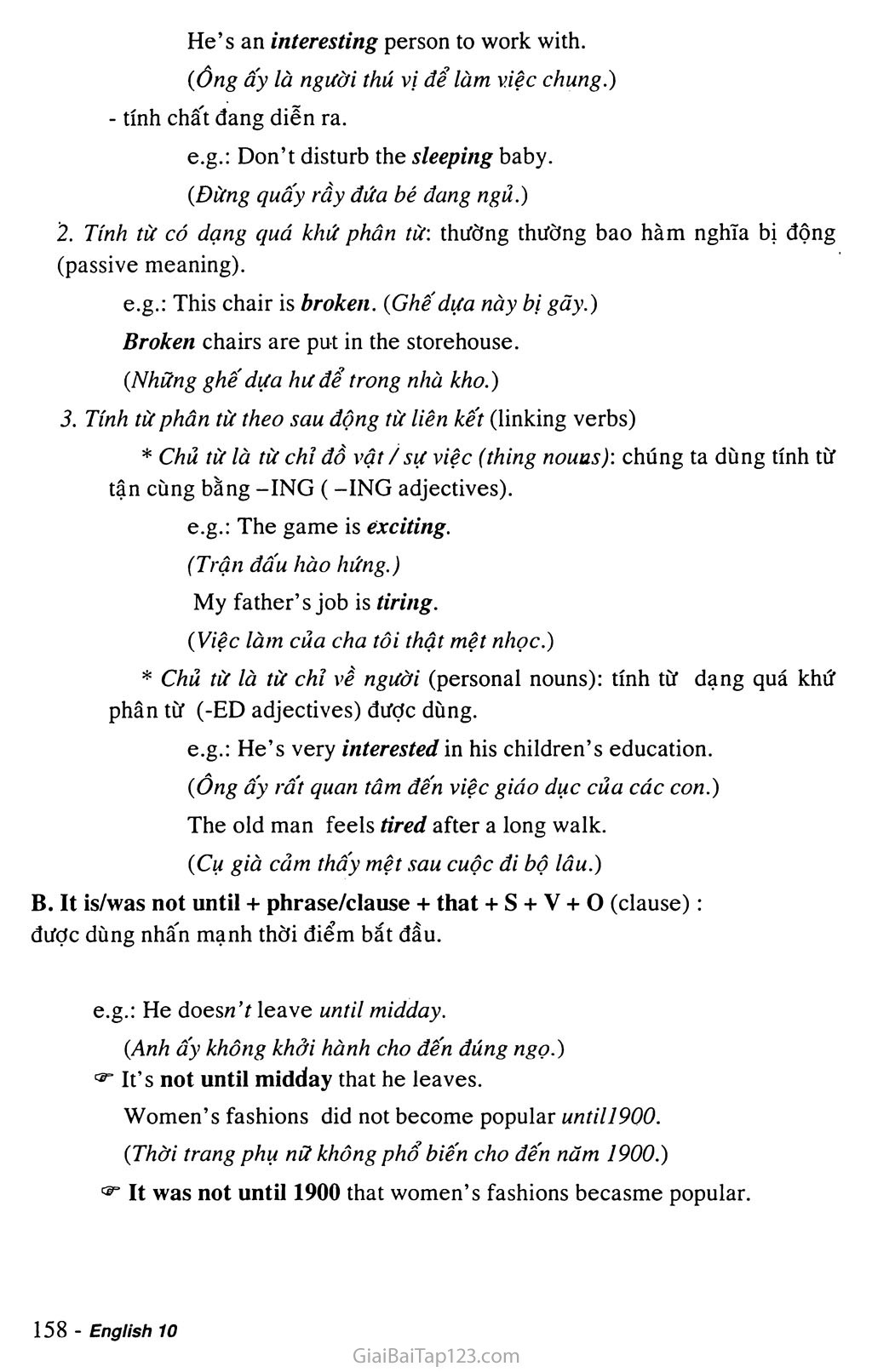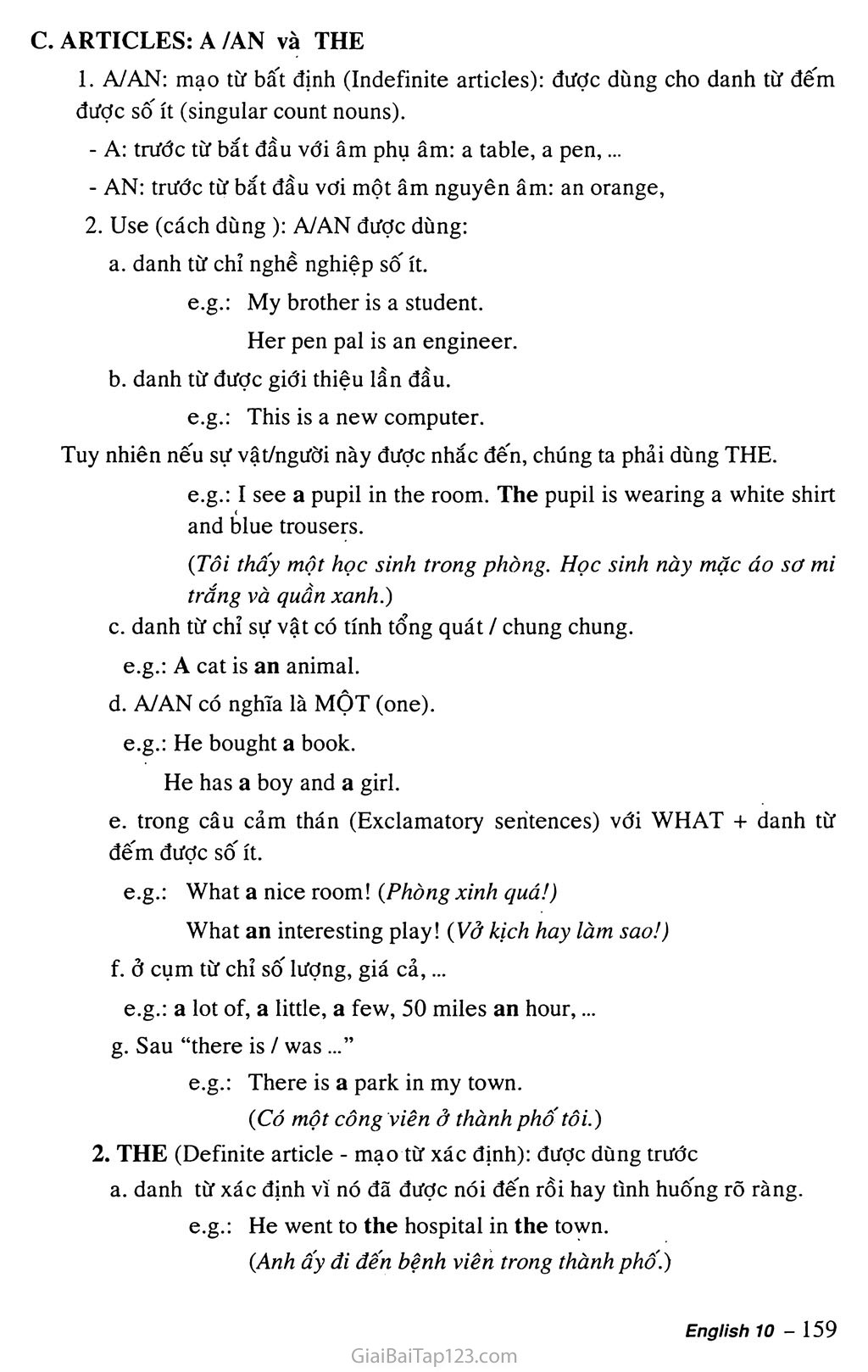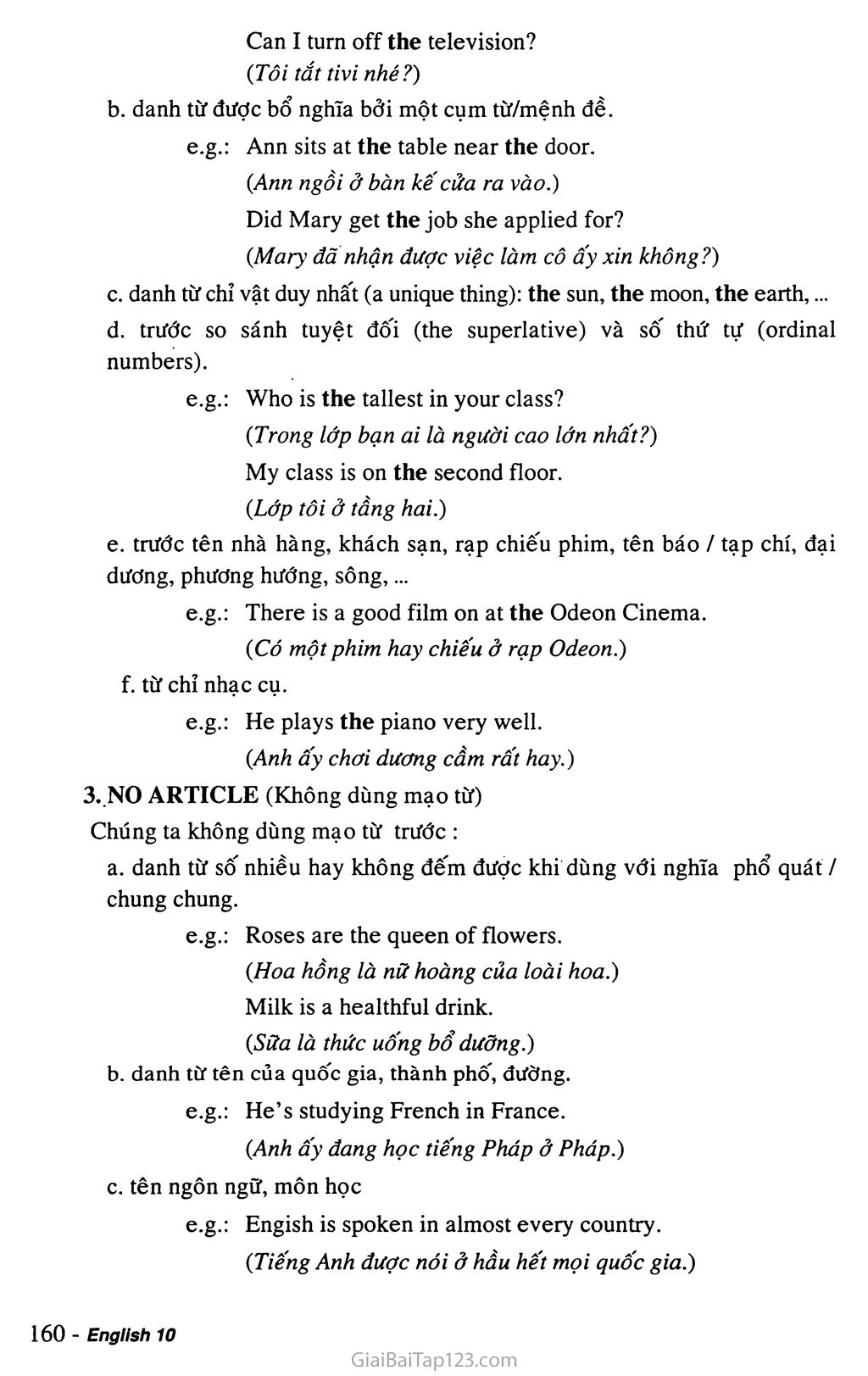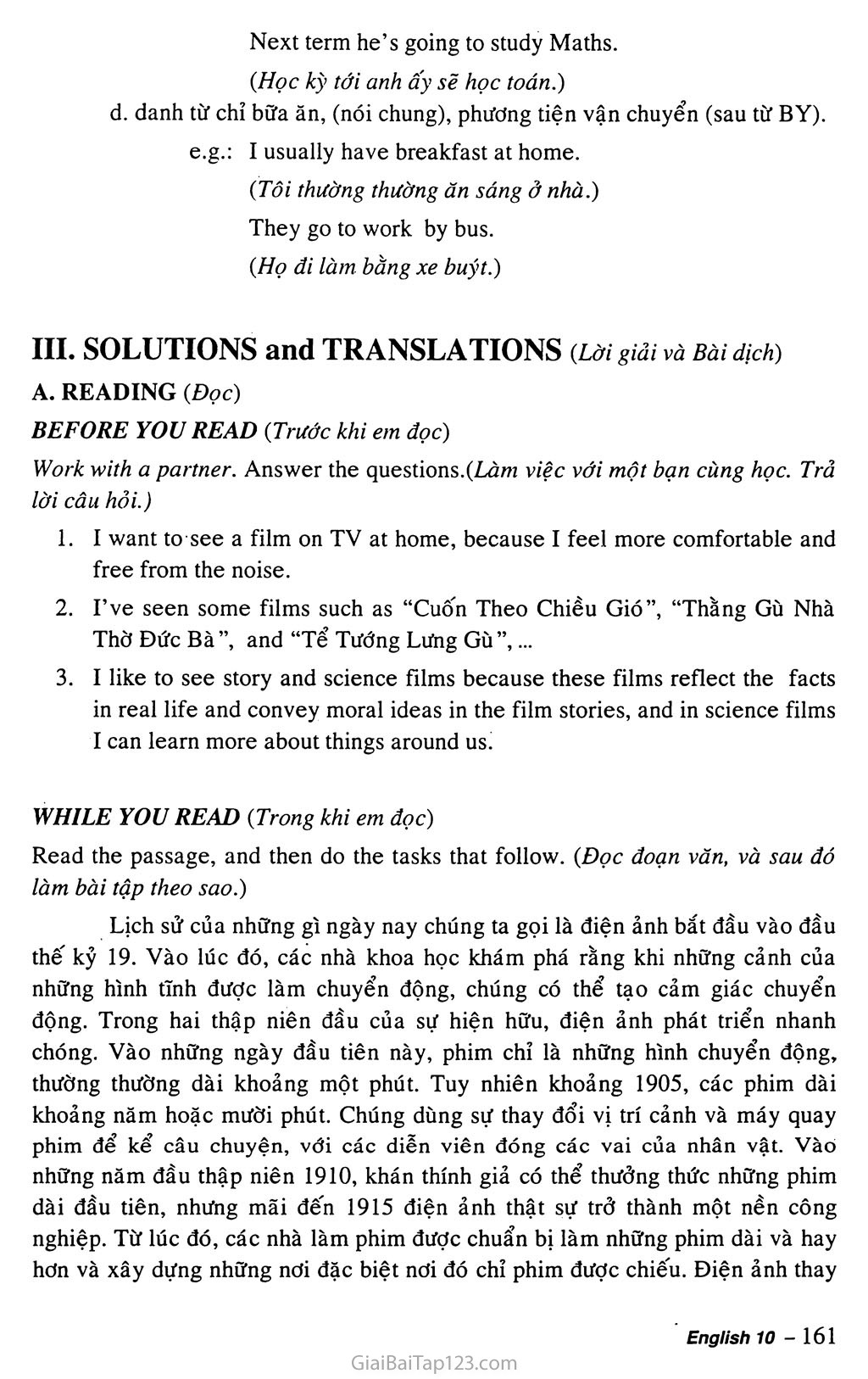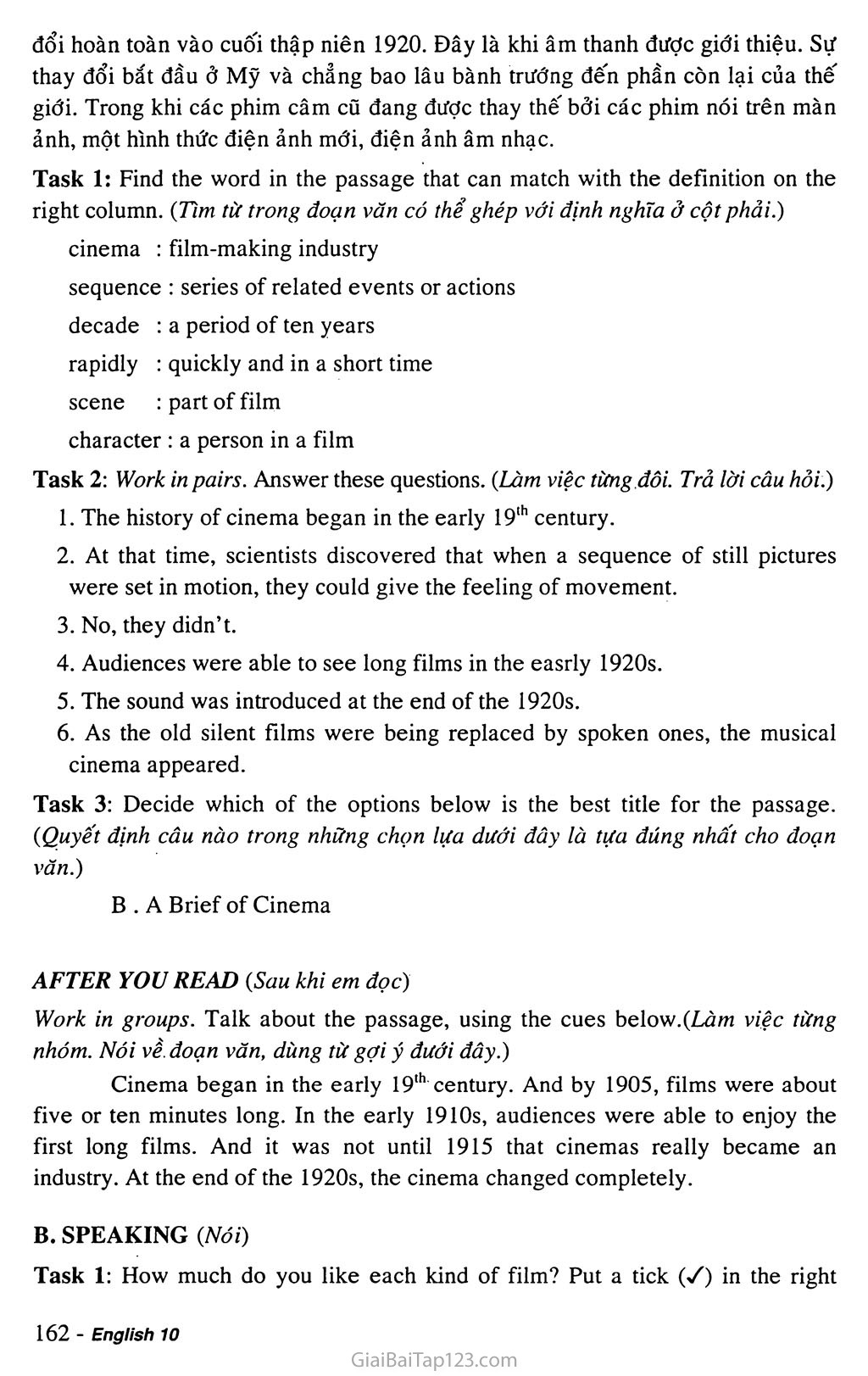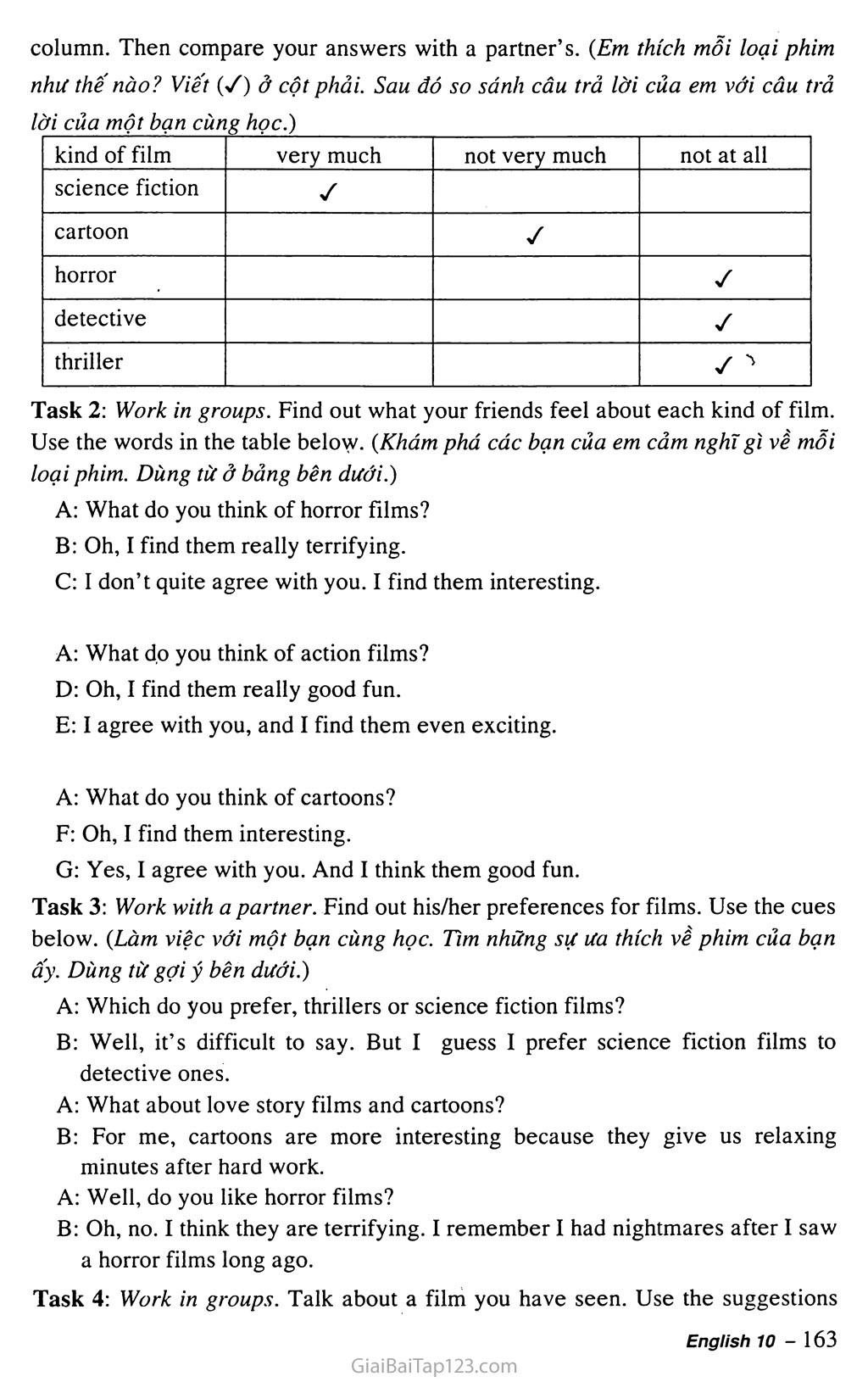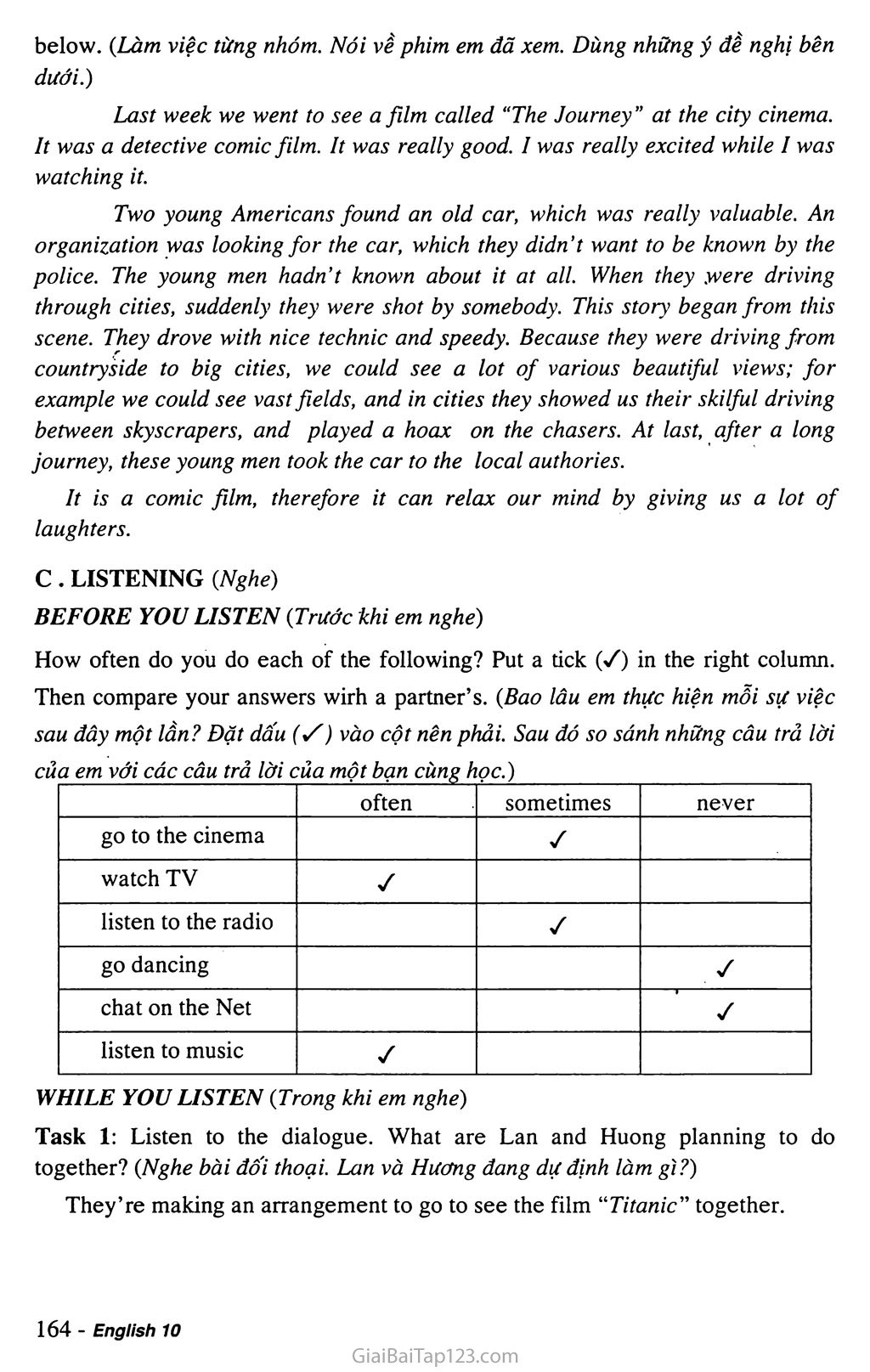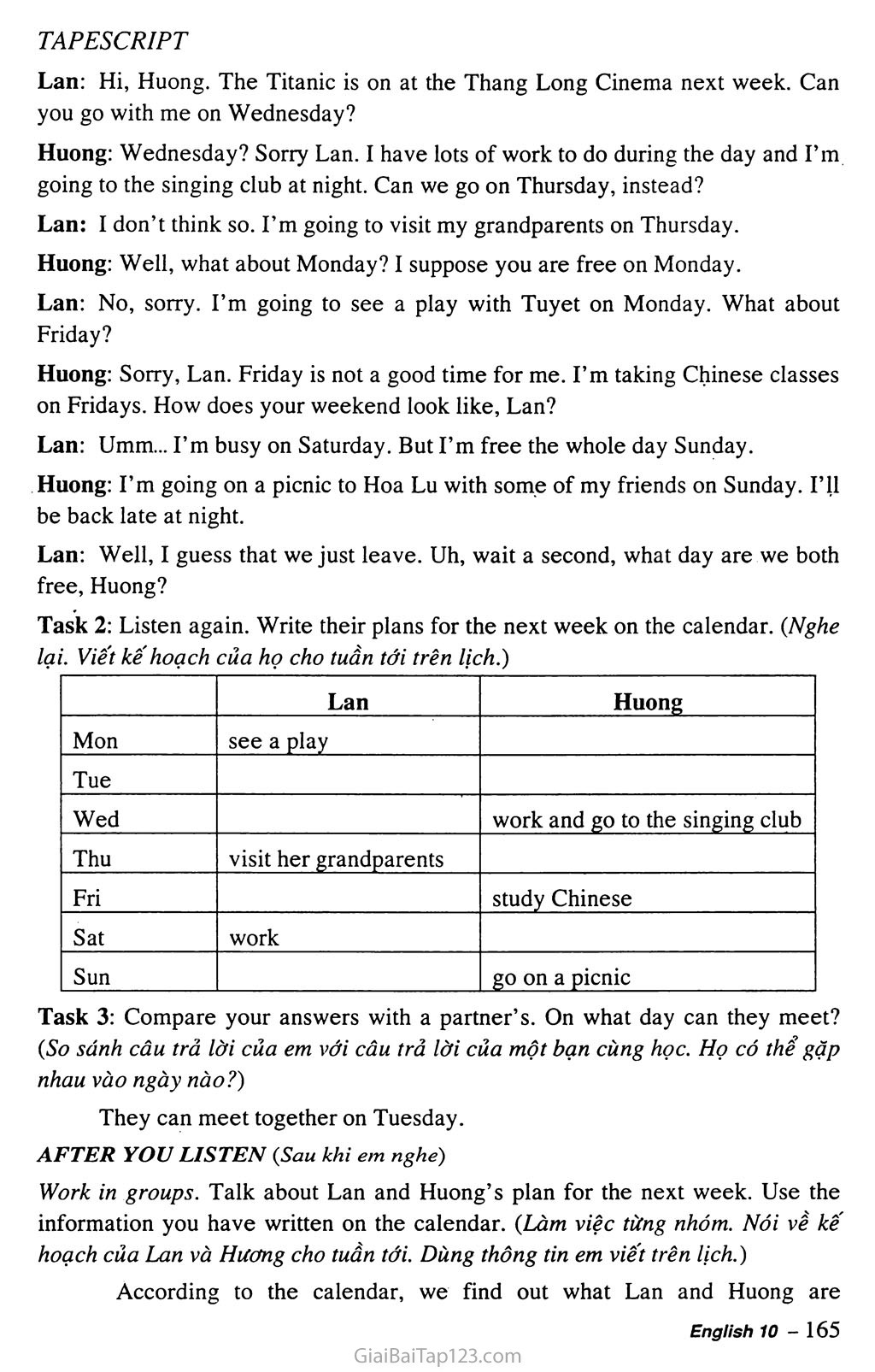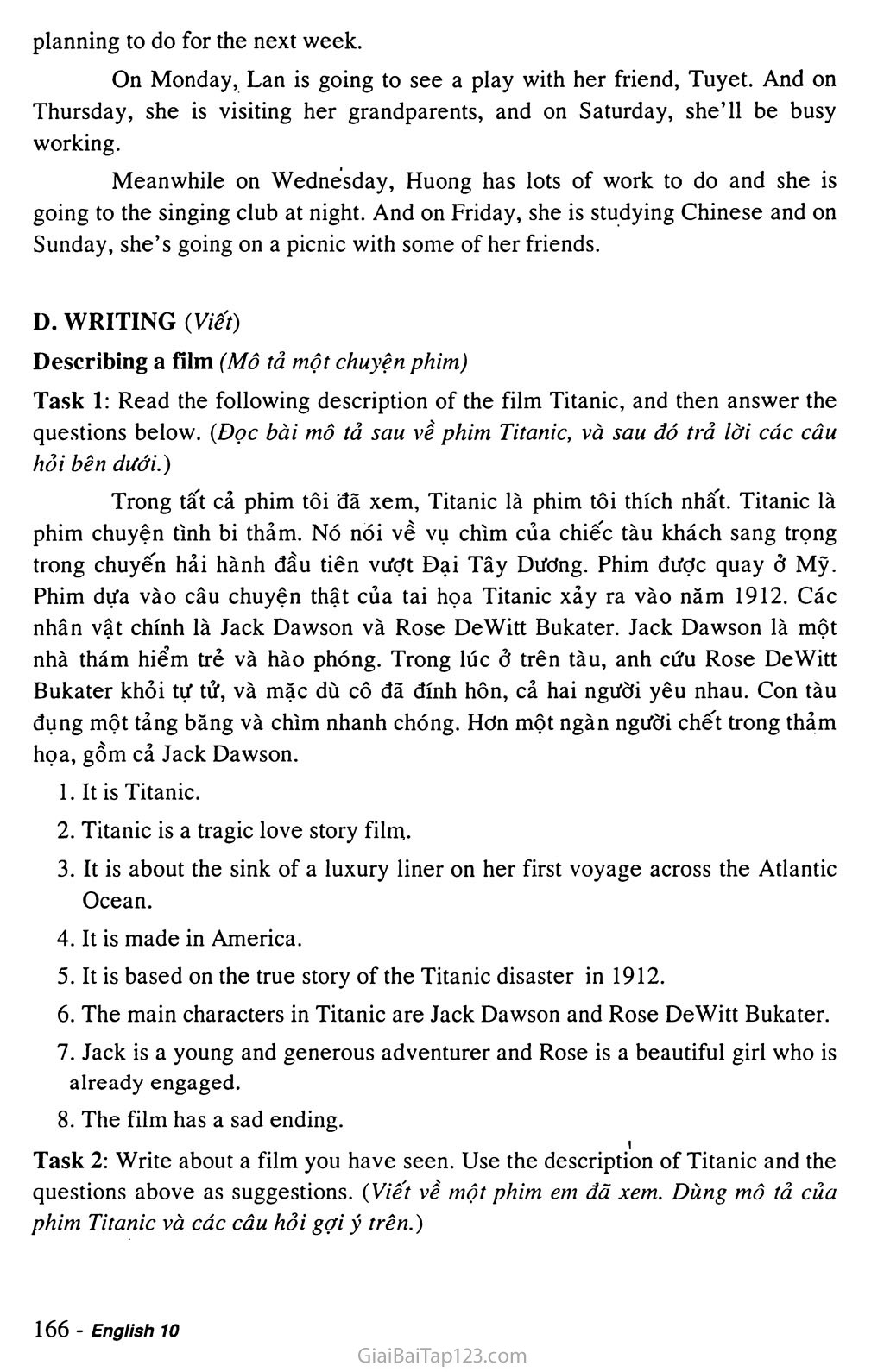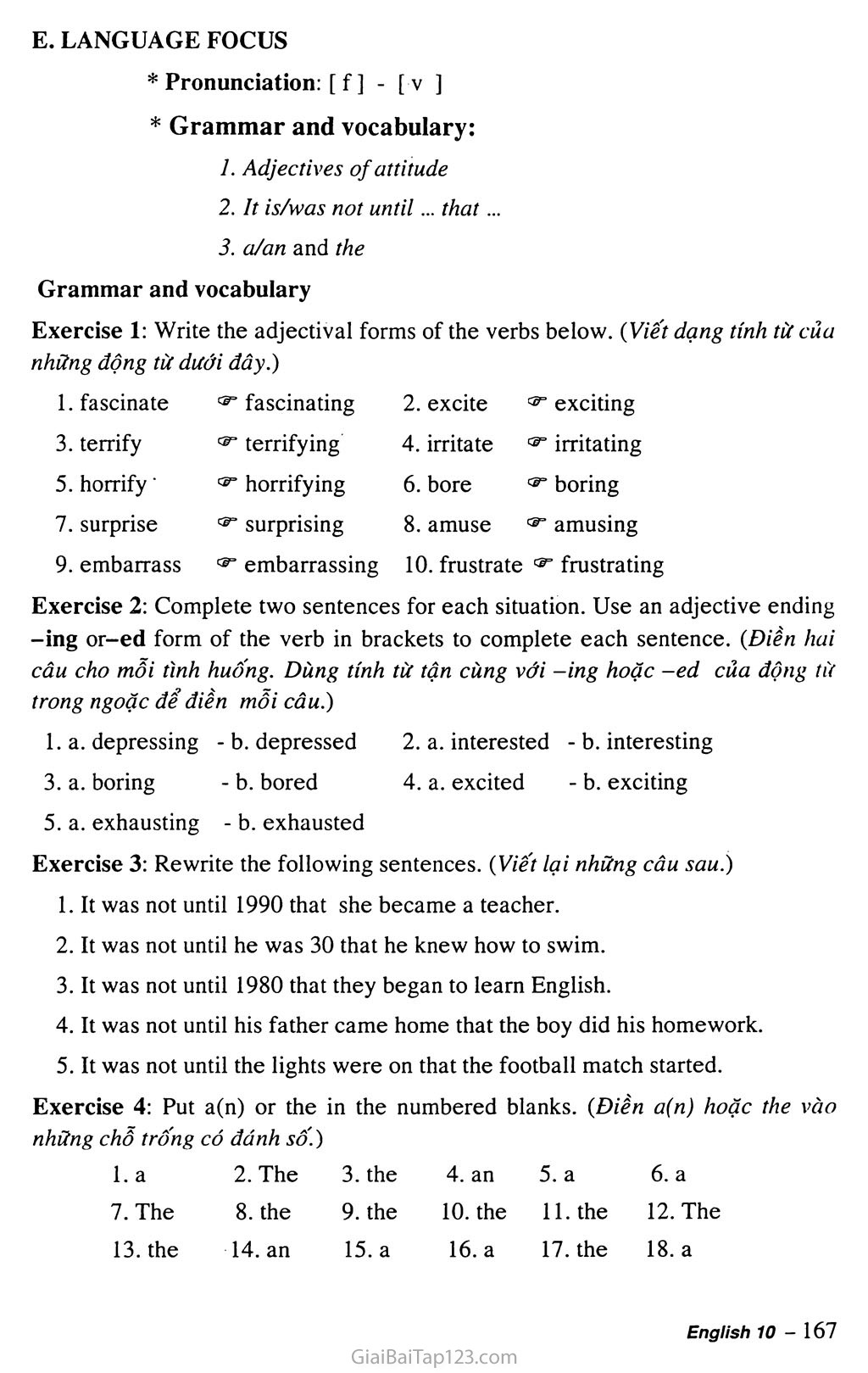Giải tiếng Anh lớp 10 Unit 13: Films and Cinema
HỖ
FILMS AND CINEMA
(Phim và Điện ảnh)
I. VOCABULARY
discover [di’skAva]
(v) : khám phá
discovery [di’skAvari]
(n) : sự khám phá
still [stil]
(adj) : yên tĩnh
still picture
(n) : hình không cử động/tĩnh
motion [‘maojn]
(n) : động, sự chuyển động
in motion
(prep.phr) : đang chuyển động
motionless [‘maujnlis]
(adj) : bất động
motional [‘maujnal]
(adj) : vận động, chuyển động
decade [‘dekeid]
(n) : thập niên (10 năm)
character [‘kaerakta]
(n ) : nhân vật
play character part
(v) : đóng vai nhân vật
audience [‘o:dians]
(n): khán thính giả, cử tọa
film maker
(n) : người làm phim
silent [‘sailant]
(adj) : yên lặng
silent film
(n) : phim câm
screen [ skri:n]
(n) : màn hình
science fiction [‘saians fikjn]
(n): phim khoa học viễn tưởng
horror [‘hDra]
(n): sự kinh dị
horrible [‘hDrabl]
(adj): kinh dị
horror film
(n): phim kinh dị
detective film [dl’tektiv film]
(n) : phim trinh thám
thriller [ ‘erila]
(n): truyện trinh thám/ly kỳ
thill [eril]
(v) : làm rùng mình, rung động
thrilling [‘erilir)]
(adj): hồi hộp, ly kỳ
terrify [‘terifai]
(v) : làm kinh hoàng/hoảng sợ
terror [‘tera]
(n): sự kinh hoàng/sỢ hãi
terrible [‘terabl]
(adj) : kinh hoàng/sợ hãi
love story film
(n): phim tâm lý tình cảm
war [wo:]
(n): chiến tranh
warlike [‘wo: laik ]
(adj) : hiếu chiến
action film [‘askjn film]
(n) : phim hành động
violent [‘vaialant]
(adj): bạo lực
violence [ ‘vaialans]
(n) : bạo lực
preference [‘prefrans]
(n) : sự ưa/thích chuộng hơn; sở
prefer [pri’f3:]
(v) : thích hơn
preferable [‘prefarabl]
(adj) : đáng ưa/thích hơn
tragic [‘traeifeik]
(adj): bi thảm
tragedy [‘trsetfeadi]
(adj): bi kịch
sink /sank /sunk [sir)k/ sasqk /sAỊ)k ] (v): chìm
luxury [ ‘Mkfari]
(n): sự xa hoa
luxurious [Ug’zjuarias]
(adj) : xa hoa / xa xỉ, sang trọng
liner [‘laina]
(n) : tàu (biển) chở khách
voyage [‘voinfc ]
(n) : chuyến hải hành
generous [‘(feenaras]
(adj) : hào phóng, rộng lượng
generosity [(feena’rDsati]
(n): tính hào phóng/bao dung
adventurer [ad’ventja]
(n) : nhà thám hiểm
on board
(prep) : trên tàu
II. GRAMMAR
A. ADJECTIVES of ATTITUDE (Tính từ chỉ thái độ)
Tính từ chỉ thái độ hay tính từ phân từ (Participial adjectives) tận cùng bằng- ING hay quá khứ phân từ (past participle): interesting - interested; boring - bored; exciting - excited,...
1. Tính từ tận cùng bằng -ING: bao hàm;
- nghĩa tác động (active meaning).
e.g.: This film is interesting. (Phim này hay.)
be engaged [bi: in’geitfcd] fall in love (with) iceberg [laisb3:g] van [vaen] valley [‘vseli] fascinate [‘fassineit]
fascination [fassi’neifn] irritate [‘iriteit]
irritation [iri’teijn]
embarrass [im’baaras]
embarrassment [im’baerasmant] amuse [a’mju:z]
amusement [a’mju:zmant] frustrate [frA’streit ]
frustration [fryC streijn] astronomy [a’strDnami] interest [‘intrast] exhaust [ig’zo:st]
exhaustion [ig’zo:stfn] crash into [kraej] badly [ basdli] be damaged [ bi: daamicfod] owner [‘aona]
own [aun] (v): đính hôn
(v): yêu (ai), phải lòng ai
(n) : băng sơn
(n) : xe chở hàng
(n) : thung lũng
(v) : làm say mê, quyến rũ (n):sự quyến rũ (v) : làm phát cáu, chọc tức (n): sự chọc tức
(v) : làm ai ngượng ngùng/lúng túng (n) : sự ngượng ngùng/lúng túng (v) : làm vui
(n) : niềm vui, sự thích thú
(v) : làm thất vọng
(n) : sự làm thất vọng
(n) : thiên văn học
(n) : hobby: sở thích
(v) : làm kiệt sức/kiệt quệ
(n) : tình trạng mệt lả/kiệt sức
(v) : đâm/đụng vào
(adv) : serious, very much: trầm trọng
(v) : bị hư hại/thiệt hại
(n) : chủ sở hữu
(v) : possess: sở hữu
He’s an interesting person to work with.
(ông ấy là người thú vị để làm v.iệc chung.)
- tính chất đang diễn ra.
g.: Don’t disturb the sleeping baby.
(Đừng quấy rầy đứa bé đang ngủ.)
Tính từ có dạng quá khứ phân từ: thường thường bao hàm nghĩa bị động (passive meaning).
e.g.: This chair is broken. (Ghếdựa này bị gãy.)
Broken chairs are put in the storehouse.
(Những ghế dựa hư để trong nhà kho.)
Tính từ phân từ theo sau động từ liên kết (linking verbs)
Chủ từ là từ chỉ đồ vật / sự việc (thing nouns): chúng ta dùng tính từ tận cùng bằng -ING ( -ING adjectives).
e.g.: The game is exciting.
(Trận đấu hào hứng.)
My father’s job is tiring.
(Việc làm của cha tôi thật mệt nhọc.)
Chủ từ là từ chỉ về người (personal nouns): tính từ dạng quá khứ phân từ (-ED adjectives) được dùng.
e.g.: He’s very interested in his children’s education.
(Ong ấy rất quan tâm đến việc giáo dục của các con.)
The old man feels tired after a long walk.
(Cụ già cảm thấy mệt sau cuộc di bộ lâu.)
B. It is/was not until + phrase/clause + that + s + V + o (clause):
được dùng nhân mạnh thời điểm bắt đầu.
e.g.: He doesn’t leave until midday.
(Anh ấy không khởi hành cho đến đúng ngọ.)
It’s not until midday that he leaves.
Women’s fashions did not become popular until)900.
(Thời trang phụ nữ không phổ biến cho đến năm 1900.)
It was not until 1900 that women’s fashions becasme popular.
ARTICLES: A /AN và THE
A/AN: mạo từ bất định (Indefinite articles): được dùng cho danh từ đếm được số ít (singular count nouns).
A: trước từ bắt đầu với âm phụ âm: a table, a pen,...
AN: trước từ bắt đầu vơi một âm nguyên âm: an orange,
Use (cách dùng ): AAN được dùng:
danh từ chỉ nghề nghiệp số ít.
e.g.: My brother is a student.
Her pen pal is an engineer.
danh từ được giới thiệu lần đầu.
e.g.: This is a new computer.
Tuy nhiên nếu sự vật/người này được nhắc đến, chúng ta phải dùng THE.
e.g.: I see a pupil in the room. The pupil is wearing a white shirt and blue trousers.
(Tôi thấy một học sinh trong phòng. Học sinh này mặc áo sơ mi trắng và quần xanh.)
danh từ chỉ sự vật có tính tổng quát / chung chung, e.g.: A cat is an animal.
A/AN có nghĩa là MỘT (one),
g.: He bought a book.
He has a boy and a girl.
trong câu cảm thán (Exclamatory sentences) với WHAT + danh từ đếm được sô' ít.
e.g.: What a nice room! (Phòng xinh quá!)
What an interesting play! (Vở kịch hay làm sao!)
ở cụm từ chỉ sô" lượng, giá cả,...
e.g.: a lot of, a little, a few, 50 miles an hour,...
Sau “there is / was ...”
e.g.: There is a park in my town.
(Có một công viên ở thành phố tôi.)
THE (Definite article - mạo từ xác định): được dùng trước
danh từ xác định vĩ nó đã được nói đến rồi hay tình huông rõ ràng.
e.g.: He went to the hospital in the town.
(Anh ấy đi đến bệnh viên trong thành phố.)
Can I turn off the television?
{Tôi tắt tivi nhé?)
danh từ được bổ nghĩa bởi một cụm từ/mệnh đề.
e.g.: Ann sits at the table near the door.
{Ann ngồi ở bàn kế cửa ra vào.)
Did Mary get the job she applied for?
{Mary đã nhận được việc làm cô ấy xin không?)
danh từ chỉ vật duy nhất (a unique thing): the sun, the moon, the earth,...
trước so sánh tuyệt đối (the superlative) và số thứ tự (ordinal numbers).
g.: Who is the tallest in your class?
{Trong lớp bạn ai là người cao lớn nhất?)
My class is on the second floor.
{Lớp tôi ở tầng hai.)
trước tên nhà hàng, khách sạn, rạp chiếu phim, tên báo / tạp chí, đại dương, phương hướng, sông,...
e.g.: There is a good film on at the Odeon Cinema.
{Có một phim hay chiếu ở rạp Odeon.)
f. từ chỉ nhạc cụ.
e.g.: He plays the piano very well.
{Anh ấy chơi dương cầm rất hay.)
3..NO ARTICLE (Không dùng mạo từ)
Chúng ta không dùng mạo từ trước :
danh từ số nhiều hay không đếm được khi dùng với nghĩa phổ quát/ chung chung.
e.g.: Roses are the queen of flowers.
{Hoa hồng là nữ hoàng của loài hoa.)
Milk is a healthful drink.
{Sữa là thức uống bổ dưỡng.)
danh từ tên của quốc gia, thành phô', đường.
e.g.: He’s studying French in France.
{Anh ấy đang học tiếng Pháp ở Pháp.)
tên ngôn ngữ, môn học
e.g.: Engish is spoken in almost every country.
{Tiếng Anh được nói ở hầu hết mọi quốc gia.)
Next term he’s going to study Maths.
{Học kỳ tới anh ấy sẽ học toán.)
danh từ chỉ bữa ăn, (nói chung), phương tiện vận chuyển (sau từ BY),
g.: I usually have breakfast at home.
{Tôi thường thường ăn sáng ở nhà.)
They go to work by bus.
{Họ đi làm bằng xe buýt.)
III. SOLUTIONS and TRANSLATIONS {Lời giải và Bài dịch)
A. READING {Đọc)
BEFORE YOU READ {Trước khi em đọc)
Work with a partner. Answer the questions.{Làm việc với một bạn cùng học. Trả lời câu hỏi.)
I want to see a film on TV at home, because I feel more comfortable and free from the noise.
I’ve seen some films such as “Cuốn Theo Chiều Gió”, “Thằng Gù Nhà Thờ Đức Bà”, and “Tể Tướng Lưng Gù”,...
I like to see story and Science films because these films reflect the facts in real life and convey moral ideas in the film stories, and in science films I can learn more about things around US.
WHILE YOU READ {Trong khi em đọc)
Read the passage, and then do the tasks that follow. {Đọc đoạn văn, và sau đó làm bài tập theo sao.)
Lịch sử của những gì ngày nay chúng ta gọi là điện ảnh bắt đầu vào đầu thế kỷ 19. Vào lúc đó, các nhà khoa học khám phá rằng khi những cảnh của những hình tĩnh được làm chuyển động, chúng có thể tạo cảm giác chuyển động. Trong hai thập niên đầu của sự hiện hữu, điện ảnh phát triển nhanh chóng. Vào những ngày đầu tiên này, phim chỉ là những hình chuyển động, thường thường dài khoảng một phút. Tuy nhiên khoảng 1905, các phim dài khoảng năm hoặc mười phút. Chúng dùng sự thay đổi vị trí cảnh và máy quay phim để kể câu chuyện, với các diễn viên đóng các vai của nhân vật. Vào những năm đầu thập niên 1910, khán thính giả có thể thưởng thức những phim dài đầu tiên, nhưng mãi đến 1915 điện ảnh thật sự trở thành một nền công nghiệp. Từ lúc đó, các nhà làm phim được chuẩn bị làm những phim dài và hay hơn và xây dựng những nơi đặc biệt nơi đó chỉ phim được chiếu. Điện ảnh thay đổi hoàn toàn vào cuối thập niên 1920. Đây là khi âm thanh được giới thiệu. Sự thay đổi bắt đầu ở Mỹ và chẳng bao lâu bành trướng đến phần còn lại của thế giới. Trong khi các phim câm cũ đang được thay thế bởi các phim nói trên màn ảnh, một hình thức điện ảnh mới, điện ảnh âm nhạc.
Task 1: Find the word in the passage that can match with the definition on the right column. (Fun từ trong đoạn văn có thể ghép với định nghĩa ở cột phải.)
cinema : film-making industry
sequence : series of related events or actions
decade : a period of ten years
rapidly : quickly and in a short time scene : part of film character : a person in a film
Task 2: Work in pairs. Answer these questions. (Làm việc từng đôi. Trả lời câu hỏi.)
The history of cinema began in the early 19lh century.
At that time, scientists discovered that when a sequence of still pictures were set in motion, they could give the feeling of movement.
No, they didn’t.
Audiences were able to see long films in the easrly 1920s.
The sound was introduced at the end of the 1920s.
As the old silent films were being replaced by spoken ones, the musical cinema appeared.
Task 3: Decide which of the options below is the best title for the passage. (Quyết định câu nào trong những chọn lựa dưới đây là tựa đúng nhất cho đoạn văn.)
B . A Brief of Cinema
AFTER YOU READ (Sau khi em đọc)
Work in groups. Talk about the passage, using the cues below .(Làm việc từng nhóm. Nói về. đoạn văn, dùng từ gợi ý dưới đây.)
Cinema began in the early 19th century. And by 1905, films were about five or ten minutes long. In the early 1910s, audiences were able to enjoy the first long films. And it was not until 1915 that cinemas really became an industry. At the end of the 1920s, the cinema changed completely.
B. SPEAKING (Nói)
Task 1: How much do you like each kind of film? Put a tick (■/) in the right
column. Then compare your answers with a partner’s. (Em thích mỗi loại phim như thế nào? Viết (Z) ở cột phải. Sau đó so sánh câu trả lời của em với câu trả lời của một bạn cùng học.)
kind of film
very much
not very much
not at all
science fiction
z
cartoon
z
horror
z
detective
z
thriller
z '
Task 2: Work in groups. Find out what your friends feel about each kind of film. Use the words in the table below. (Khám phá các bạn của em cảm nghĩ gì về mỗi loại phim. Dùng từ ở bảng bên dưới.)
A: What do you think of horror films?
B: Oh, I find them really terrifying.
C: I don’t quite agree with you. I find them interesting.
A: What do you think of action films?
D: Oh, I find them really good fun.
E: I agree with you, and I find them even exciting.
A: What do you think of cartoons?
F: Oh, I find them interesting.
G: Yes, I agree with you. And I think them good fun.
Task 3: Work with a partner. Find out his/her preferences for films. Use the cues below. (Làm việc với một bạn cùng học. Tìm những sự ưa thích về phim của bạn ấy. Dùng từ gợi ý bên dưới.)
A: Which do you prefer, thrillers or science fiction films?
B: Well, it’s difficult to say. But I guess I prefer science fiction films to
detective ones.
A: What about love story films and cartoons?
B: For me, cartoons are more interesting because they give US relaxing minutes after hard work.
A: Well, do you like horror films?
B: Oh, no. I think they are terrifying. I remember I had nightmares after I saw a horror films long ago.
Task 4: Work in groups. Talk about a film you have seen. Use the suggestions English 10 - 163
below. {Làm việc từng nhóm. Nói về phim em đã xem. Dùng những ý đề nghị bên dưới.)
Last week we went to see a film called “The Journey’’ at the city cinema. It was a detective comic film. It was really good. I was really excited while I was watching it.
Two young Americans found an old car, which was really valuable. An organization was looking for the car, which they didn’t want to be known by the police. The young men hadn’t known about it at all. When they were driving through cities, suddenly they were shot by somebody. This story began from this scene. They drove with nice technic and speedy. Because they were driving from countryside to big cities, we could see a lot of various beautiful views; for example we could see vast fields, and in cities they showed US their skilful driving between skyscrapers, and played a hoax on the chasers. At last, after a long journey, these young men took the car to the local authories.
It is a comic film, therefore it can relax our mind by giving US a lot of laughters.
c. LISTENING {Nghe)
BEFORE YOU LISTEN {Trước khi em nghe)
How often do you do each of the following? Put a tick (Z) in the right column. Then compare your answers wirh a partner’s. {Bao lâu em thực hiện mỗi sự việc sau đây một lần? Đặt dấu (s) vào cột nên phải. Sau đó so sánh những câu trả lời của em với các câu trả lời của một bạn cùng học.)
often
sometimes
never
go to the cinema
z
watch TV
z
listen to the radio
z
go dancing
z
chat on the Net
z
listen to music
z
WHILE YOU LISTEN {Trong khi em nghe)
Task 1: Listen to the dialogue. What are Lan and Huong planning to do together? {Nghe bài đối thoại. Lan và Hương đang dự định làm gì?)
They’re making an arrangement to go to see the film “Titanic” together.
TAPESCRIPT
Lan: Hi, Huong. The Titanic is on at the Thang Long Cinema next week. Can you go with me on Wednesday?
Huong: Wednesday? Sorry Lan. I have lots of work to do during the day and I’m going to the singing club at night. Can we go on Thursday, instead?
Lan: I don’t think so. I’m going to visit my grandparents on Thursday.
Huong: Well, what about Monday? I suppose you are free on Monday.
Lan: No, sorry. I’m going to see a play with Tuyet on Monday. What about Friday?
Huong: Sorry, Lan. Friday is not a good time for me. I’m taking Chinese classes on Fridays. How does your weekend look like, Lan?
Lan: Umm... I’m busy on Saturday. But I’m free the whole day Sunday.
Huong: I’m going on a picnic to Hoa Lu with some of my friends on Sunday. I’ll be back late at night.
Lan: Well, I guess that we just leave. Uh, wait a second, what day are we both free, Huong?
Task 2: Listen again. Write their plans for the next week on the calendar. (Nghe lại. Viết kế hoạch của họ cho tuần tới trên lịch.)
Lan
Huong
Mon
see a play
Tue
Wed
work and go to the singing club
Thu
visit her grandparents
Fri
study Chinese
Sat
work
Sun
go on a picnic
Task 3: Compare your answers with a partner’s. On what day can they meet? (So sánh câu trả lời của em với câu trả lời của một bạn cùng học. Họ có thể gặp nhau vào ngày nào?}
They can meet together on Tuesday.
AFTER YOU LISTEN (Sau khi em nghe}
Work in groups. Talk about Lan and Huong’s plan for the next week. Use the information you have written on the calendar. (Làm việc từng nhóm. Nói về kế hoạch của Lan và Hương cho tuần tới. Dùng thông tin em viết trên lịch.}
According to the calendar, we find out what Lan and Huong are English 10 - 165
planning to do for the next week.
On Monday, Lan is going to see a play with her friend, Tuyet. And on Thursday, she is visiting her grandparents, and on Saturday, she’ll be busy working.
Meanwhile on Wednesday, Huong has lots of work to do and she is going to the singing club at night. And on Friday, she is studying Chinese and on Sunday, she’s going on a picnic with some of her friends.
D. WRITING (Viết)
Describing a film (Mô tả một chuyện phim)
Task 1: Read the following description of the film Titanic, and then answer the questions below. (Đọc bài mô tả sau về phim Titanic, và sau đó trả lời các câu hỏi bên dưới.)
Trong tất cả phim tôi 'đã xem, Titanic là phim tôi thích nhất. Titanic là phim chuyện tình bi thảm. Nó nói về vụ chìm của chiếc tàu khách sang trọng trong chuyên hải hành đầu tiên vượt Đại Tây Dương. Phim được quay ở Mỹ. Phim dựa vào câu chuyện thật của tai họa Titanic xảy ra vào năm 1912. Các nhân vật chính là Jack Dawson và Rose DeWitt Bukater. Jack Dawson là một nhà thám hiểm trẻ và hào phóng. Trong lúc ở trên tàu, anh cứu Rose DeWitt Bukater khỏi tự tử, và mặc dù cô đã đính hôn, cả hai người yêu nhau. Con tàu đụng một tảng băng và chìm nhanh chóng. Hơn một ngàn người chết trong thảm họa, gồm cả Jack Dawson.
It is Titanic.
Titanic is a tragic love story film.
It is about the sink of a luxury liner on her first voyage across the Atlantic Ocean.
It is made in America.
It is based on the true story of the Titanic disaster in 1912.
The main characters in Titanic are Jack Dawson and Rose DeWitt Bukater.
Jack is a young and generous adventurer and Rose is a beautiful girl who is already engaged.
The film has a sad ending.
Task 2: Write about a film you have seen. Use the description of Titanic and the questions above as suggestions. (Viết về một phim em đã xem. Dùng mô tả của phim Titanic và các câu hỏi gợi ý trên.)
E. LANGUAGE FOCUS
Pronunciation: [ f ] - [ V ]
Grammar and vocabulary:
Adjectives of attitude
It is/was not until... that...
a/an and the
Grammar and vocabulary
Exercise 1: Write the adjectival forms of the verbs below. (Viết dạng tính từ của những động từ dưới đây.)
fascinate
fascinating
2. excite
exciting
terrify
terrifying
4. irritate
irritating
horrify'
horrifying
6. bore
boring
surprise
surprising
8. amuse
amusing
embarrass
embarrassing
10. frustrate
frustrating
Exercise 2: Complete two sentences for each situation. Use an adjective ending -ing or-ed form of the verb in brackets to complete each sentence. (Điền hai câu cho mỗi tình huống. Dùng tính từ tận cùng với -ing hoặc -ed của động từ trong ngoặc để điền mỗi câu.)
a. depressing - b. depressed 2. a. interested - b. interesting
a. boring - b. bored 4. a. excited - b. exciting
5. a. exhausting - b. exhausted
Exercise 3: Rewrite the following sentences. (Viết lại những câu sau.)
It was not until 1990 that she became a teacher.
It was not until he was 30 that he knew how to swim.
It was not until 1980 that they began to learn English.
It was not until his father came home that the boy did his homework.
It was not until the lights were on that the football match started.
Exercise 4: Put a(n) or the in the numbered blanks. (Điền a(n) hoặc the vào những chỗ trống có đánh số.)
1. a
2. The
3. the
4. an
5. a
6. a
7. The
8. the
9. the
10. the
11. the
12. The
13.the
14. an
15. a
16. a
17. the
18. a

